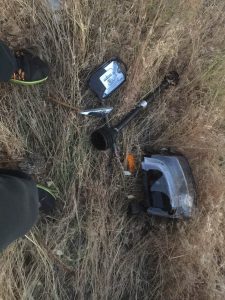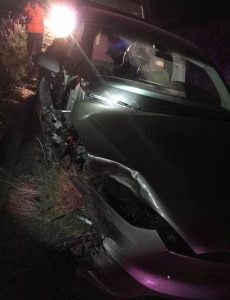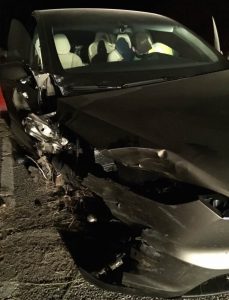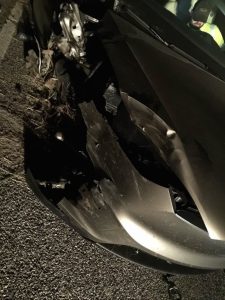News
Driver of Model X crash in Montana pens open letter to Musk, calls Tesla drivers “lab rats” [Updated]
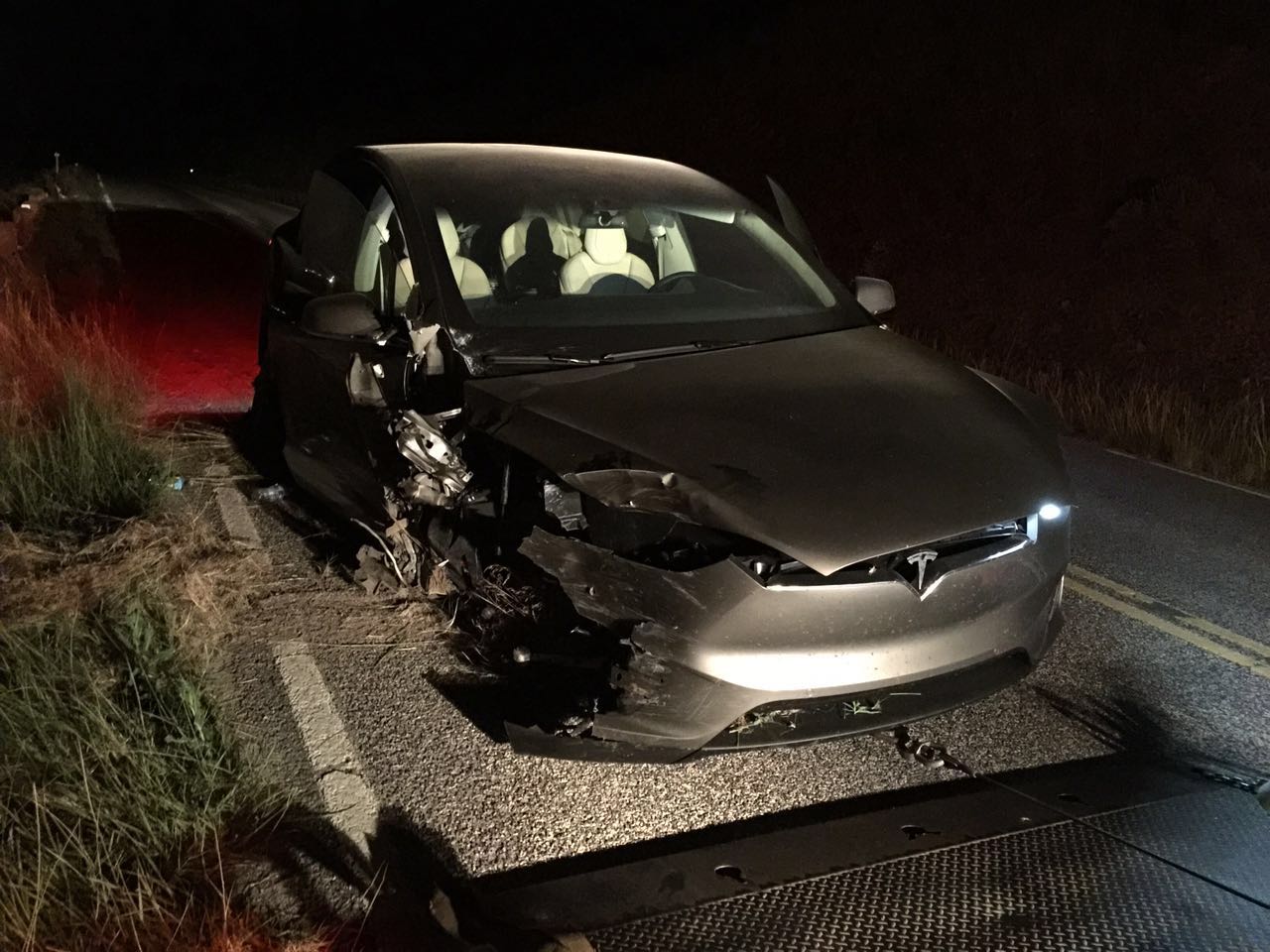
Pang, the driver of the Model X that crashed in Montana earlier this month has posted an open letter to Elon Musk and Tesla asking the company to “take responsibility for the mistakes of Tesla products”. He accuses Tesla for allegedly using drivers as “lab rats” for testing of its Autopilot system.
In an email sent to us and also uploaded to the Tesla Motors Club forum, Pang provides a detailed account of what happened the day of the crash. He says he and a friend drove about 600 miles on Interstate 90 on the way to Yellowstone National Park. When he exited the highway to get on Montana route 2, he drove for about a mile, saw conditions were clear, and turned on Autopilot again. Pang describes what happened next as follows:
“After we drove about another mile on state route 2, the car suddenly veered right and crashed into the safety barrier post. It happened so fast, and we did not hear any warning beep. Autopilot did not slow down at all after the crash, but kept going in the original speed setting and continued to crash into more barrier posts in high speed. I managed to step on the break, turn the car left and stopped the car after it crashed 12 barrier posts.
“After we stopped, we heard the car making abnormal loud sound. Afraid that the battery was broken or short circuited, we got out and ran away as fast as we could. After we ran about 50 feet, we found the sound was the engine were still running in high speed. I returned to the car and put it in parking, that is when the loud sound disappeared.”
Pang goes on to explain how his Tesla Model X driving on Autopilot continued to travel on its own even after veering off the road and crashing into a roadside stake. “I was horrified by the fact that the Tesla autopilot did not slow down the car at all after the intial crash. After we crashed on the first barrier post, autopilot continued to drive the car with the speed of 55 to 60 mph, and crashed another 11 posts. Even after I stopped the car, it was still trying to accelerate and spinning the engine in high speed. What if it is not barrier posts on the right side, but a crowd?”
Photo credit: Steven Xu
After the accident, Tesla reviewed the driving logs from the Model X and reported that the car was operating for more than two miles with no hands on the steering wheel, despite numerous alarms and warnings issued by the car. Pang says he never heard any audible warnings. Comments on TMC range from the incredulous to the acerbic. Most feel Teslas simply don’t operate the way Pang said his car did. Among other discrepancies, the cars are designed to put themselves in Park if the driver’s door is opened with no one in the driver’s seat.
But that hasn’t stopped Pang from voicing his strong opinions on Tesla’s Autopilot system. “It is clear that Tesla is selling a beta product with bugs to consumers, and ask the consumers to be responsible for the liability of the bugging autopilot system. Tesla is using all Tesla drivers as lab rats.”
A car that crashes but continues to accelerate is certainly a scary thought. There is no way to resolve the discrepancy between what Pang says happened and Tesla’s account of what occurred. In an updated email sent to us by friend and english translator for Mandarin speaking Pang, Tesla has reached out to Pang to address the matter.
The original open letter from Pang reads as follows:
A Public Letter to Mr. Musk and Tesla For The Sake Of All Tesla Driver’s Safety
From the survivor of the Montana Tesla autopilot crash
My name is Pang. On July 8, 2016, I drove my Tesla Model X from Seattle heading to Yellowstone Nation Park, with a friend, Mr. Huang, in the passenger seat. When we were on highway I90, I turned on autopilot, and drove for about 600 miles. I switched autopilot off while we exited I90 in Montana to state route 2. After about 1 mile, we saw that road condition was good, and turned on autopilot again. The speed setting was between 55 and 60 mph. After we drove about another mile on state route 2, the car suddenly veered right and crashed into the safety barrier post. It happened so fast, and we did not hear any warning beep. Autopilot did not slow down at all after the crash, but kept going in the original speed setting and continued to crash into more barrier posts in high speed. I managed to step on the break, turn the car left and stopped the car after it crashed 12 barrier posts. After we stopped, we heard the car making abnormal loud sound. Afraid that the battery was broken or short circuited, we got out and ran away as fast as we could. After we ran about 50 feet, we found the sound was the engine were still running in high speed. I returned to the car and put it in parking, that is when the loud sound disappeared. Our cellphone did not have coverage, and asked a lady passing by to call 911 on her cellphone. After the police arrived, we found the right side of the car was totally damaged. The right front wheel, suspension, and head light flied off far, and the right rear wheel was crashed out of shape. We noticed that the barrier posts is about 2 feet from the white line. The other side of the barrier is a 50 feet drop, with a railroad at the bottom, and a river next. If the car rolled down the steep slope, it would be really bad.
Concerning this crash accident, we want to make several things clear:
1. We know that while Tesla autopilot is on but the driver’s hand is not on the steering wheel, the system will issue warning beep sound after a while. If the driver’s hands continue to be off the steering wheel, autopilot will slow down, until the driver takes over both the steering wheel and gas pedal. But we did not hear any warning beep before the crash, and the car did not slow down either. It just veered right in a sudden and crashed into the barrier posts. Apparently the autopilot system malfunctioned and caused the crash. The car was running between 55 and 60 mph, and the barrier posts are just 3 or 4 feet away. It happened in less than 1/10 of a second from the drift to crash. A normal driver is impossible to avoid that in such a short time.
2. I was horrified by the fact that the Tesla autopilot did not slow down the car at all after the intial crash. After we crashed on the first barrier post, autopilot continued to drive the car with the speed of 55 to 60 mph, and crashed another 11 posts. Even after I stopped the car, it was still trying to accelerate and spinning the engine in high speed. What if it is not barrier posts on the right side, but a crowd?
3. Tesla never contacted me after the accident. Tesla just issued conclusion without thorough investigation, but blaming me for the crash. Tesla were trying to cover up the lack of dependability of the autopilot system, but blaming everything on my hands not on the steering wheel. Tesla were not interested in why the car veered right suddenly, nor why the car did not slow down during the crash. It is clear that Tesla is selling a beta product with bugs to consumers, and ask the consumers to be responsible for the liability of the bugging autopilot system. Tesla is using all Tesla drivers as lab rats. We are willing to talk to Tesla concerning the accident anytime, anywhere, in front of the public.
4. CNN’s article later about the accident was quoting out of context of our interview. I did not say that I do not know either Tesla or me should be responsible for the accident. I might consider buying another Tesla only if they can iron out the instability problems of their system.
As a survivor of such a bad accident, a past fan of the Tesla technology, I now realized that life is the most precious fortune in this world. Any advance in technology should be based on the prerequisite of protecting life to the maximum extend. In front of life and death, any technology has no right to ignore life, any pursue and dream on technology should first show the respect to life. For the sake of the safety of all Tesla drivers and passengers, and all other people sharing the road, Mr. Musk should stand up as a man, face up the challenge to thoroughly investigate the cause of the accident, and take responsibility for the mistakes of Tesla product. We are willing to publicly talk to you face to face anytime to give you all the details of what happened. Mr. Musk, you should immediately stop trying to cover up the problems of the Tesla autopilot system and blame the consumers.
Tesla’s Response on TMC
TM Ownership, Saturday at 12:11 PM
Dear Mr. Pang,
We were sorry to hear about your accident, but we were very pleased to learn both you and your friend were ok when we spoke through your translator on the morning of the crash (July 9). On Monday immediately following the crash (July 11), we found a member of the Tesla team fluent in Mandarin and called to follow up. When we were able to make contact with your wife the following day, we expressed our concern and gathered more information regarding the incident. We have since made multiple attempts (one Wednesday, one Thursday, and one Friday) to reach you to discuss the incident, review detailed logs, and address any further concerns and have not received a call back.
As is our standard procedure with all incidents experienced in our vehicles, we have conducted a thorough investigation of the diagnostic log data transmitted by the vehicle. Given your stated preference to air your concerns in a public forum, we are happy to provide a brief analysis here and welcome a return call from you. From this data, we learned that after you engaged Autosteer, your hands were not detected on the steering wheel for over two minutes. This is contrary to the terms of use when first enabling the feature and the visual alert presented you every time Autosteer is activated. As road conditions became increasingly uncertain, the vehicle again alerted you to put your hands on the wheel. No steering torque was then detected until Autosteer was disabled with an abrupt steering action. Immediately following detection of the first impact, adaptive cruise control was also disabled, the vehicle began to slow, and you applied the brake pedal.
Following the crash, and once the vehicle had come to rest, the passenger door was opened but the driver door remained closed and the key remained in the vehicle. Since the vehicle had been left in Drive with Creep Mode enabled, the motor continued to rotate. The diagnostic data shows that the driver door was later opened from the outside and the vehicle was shifted to park. We understand that at night following a collision the rotating motors may have been disconcerting, even though they were only powered by minimal levels of creep torque. We always seek to learn from customer concerns, and we are looking into this behavior to see if it can be improved. We are also continually studying means of better encouraging drivers to adhere to the terms of use for our driver assistance features.
We are still seeking to speak with you. Please contact Tesla service so that we can answer any further questions you may have.
Sincerely,
The Tesla team

News
Tesla FSD fleet is nearing 7 billion total miles, including 2.5 billion city miles
As can be seen on Tesla’s official FSD webpage, vehicles equipped with the system have now navigated over 6.99 billion miles.

Tesla’s Full Self-Driving (Supervised) fleet is closing in on almost 7 billion total miles driven, as per data posted by the company on its official FSD webpage.
These figures hint at the massive scale of data fueling Tesla’s rapid FSD improvements, which have been quite notable as of late.
FSD mileage milestones
As can be seen on Tesla’s official FSD webpage, vehicles equipped with the system have now navigated over 6.99 billion miles. Tesla owner and avid FSD tester Whole Mars Catalog also shared a screenshot indicating that from the nearly 7 billion miles traveled by the FSD fleet, more than 2.5 billion miles were driven inside cities.
City miles are particularly valuable for complex urban scenarios like unprotected turns, pedestrian interactions, and traffic lights. This is also the difference-maker for FSD, as only complex solutions, such as Waymo’s self-driving taxis, operate similarly on inner-city streets. And even then, incidents such as the San Francisco blackouts have proven challenging for sensor-rich vehicles like Waymos.
Tesla’s data edge
Tesla has a number of advantages in the autonomous vehicle sector, one of which is the size of its fleet and the number of vehicles training FSD on real-world roads. Tesla’s nearly 7 billion FSD miles then allow the company to roll out updates that make its vehicles behave like they are being driven by experienced drivers, even if they are operating on their own.
So notable are Tesla’s improvements to FSD that NVIDIA Director of Robotics Jim Fan, after experiencing FSD v14, noted that the system is the first AI that passes what he described as a “Physical Turing Test.”
“Despite knowing exactly how robot learning works, I still find it magical watching the steering wheel turn by itself. First it feels surreal, next it becomes routine. Then, like the smartphone, taking it away actively hurts. This is how humanity gets rewired and glued to god-like technologies,” Fan wrote in a post on X.
News
Tesla starts showing how FSD will change lives in Europe
Local officials tested the system on narrow country roads and were impressed by FSD’s smooth, human-like driving, with some calling the service a game-changer for everyday life in areas that are far from urban centers.

Tesla has launched Europe’s first public shuttle service using Full Self-Driving (Supervised) in the rural Eifelkreis Bitburg-Prüm region of Germany, demonstrating how the technology can restore independence and mobility for people who struggle with limited transport options.
Local officials tested the system on narrow country roads and were impressed by FSD’s smooth, human-like driving, with some calling the service a game-changer for everyday life in areas that are far from urban centers.
Officials see real impact on rural residents
Arzfeld Mayor Johannes Kuhl and District Administrator Andreas Kruppert personally tested the Tesla shuttle service. This allowed them to see just how well FSD navigated winding lanes and rural roads confidently. Kruppert said, “Autonomous driving sounds like science fiction to many, but we simply see here that it works totally well in rural regions too.” Kuhl, for his part, also noted that FSD “feels like a very experienced driver.”
The pilot complements the area’s “Citizen Bus” program, which provides on-demand rides for elderly residents who can no longer drive themselves. Tesla Europe shared a video of a demonstration of the service, highlighting how FSD gives people their freedom back, even in places where public transport is not as prevalent.
What the Ministry for Economic Affairs and Transport says
Rhineland-Palatinate’s Minister Daniela Schmitt supported the project, praising the collaboration that made this “first of its kind in Europe” possible. As per the ministry, the rural rollout for the service shows FSD’s potential beyond major cities, and it delivers tangible benefits like grocery runs, doctor visits, and social connections for isolated residents.
“Reliable and flexible mobility is especially vital in rural areas. With the launch of a shuttle service using self-driving vehicles (FSD supervised) by Tesla in the Eifelkreis Bitburg-Prüm, an innovative pilot project is now getting underway that complements local community bus services. It is the first project of its kind in Europe.
“The result is a real gain for rural mobility: greater accessibility, more flexibility and tangible benefits for everyday life. A strong signal for innovation, cooperation and future-oriented mobility beyond urban centers,” the ministry wrote in a LinkedIn post.
News
Tesla China quietly posts Robotaxi-related job listing
Tesla China is currently seeking a Low Voltage Electrical Engineer to work on circuit board design for the company’s autonomous vehicles.

Tesla has posted a new job listing in Shanghai explicitly tied to its Robotaxi program, fueling speculation that the company is preparing to launch its dedicated autonomous ride-hailing service in China.
As noted in the listing, Tesla China is currently seeking a Low Voltage Electrical Engineer to work on circuit board design for the company’s autonomous vehicles.
Robotaxi-specific role
The listing, which was shared on social media platform X by industry watcher @tslaming, suggested that Tesla China is looking to fill the role urgently. The job listing itself specifically mentions that the person hired for the role will be working on the Low Voltage Hardware team, which would design the circuit boards that would serve as the nervous system of the Robotaxi.
Key tasks for the role, as indicated in the job listing, include collaboration with PCB layout, firmware, mechanical, program management, and validation teams, among other responsibilities. The role is based in Shanghai.
China Robotaxi launch
China represents a massive potential market for robotaxis, with its dense urban centers and supportive policies in select cities. Tesla has limited permission to roll out FSD in the country, though despite this, its vehicles have been hailed as among the best in the market when it comes to autonomous features. So far, at least, it appears that China supports Tesla’s FSD and Robotaxi rollout.
This was hinted at in November, when Tesla brought the Cybercab to the 8th China International Import Expo (CIIE) in Shanghai, marking the first time that the autonomous two-seater was brought to the Asia-Pacific region. The vehicle, despite not having a release date in China, received a significant amount of interest among the event’s attendees.
